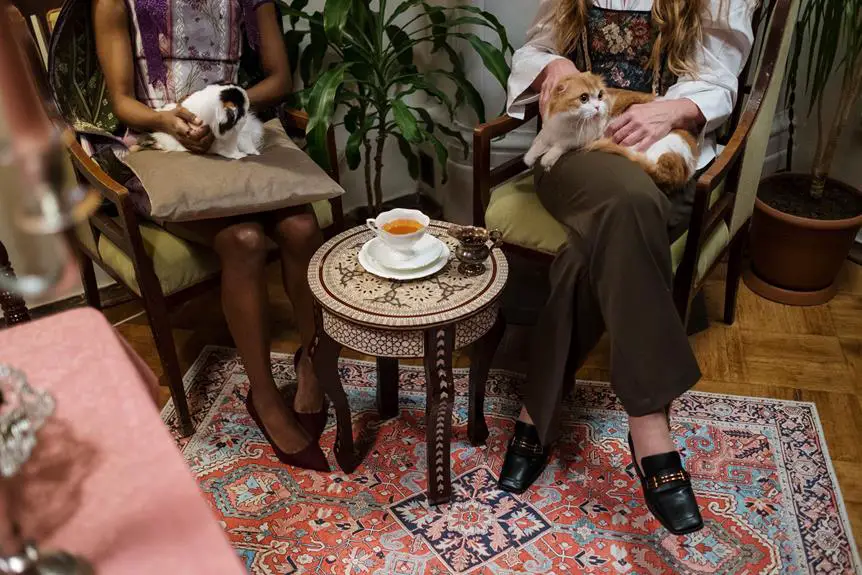Are you looking for a low-maintenance feline companion? Did you know that over 10 million Americans suffer from cat allergies?

Fortunately, there are several breeds of cats that are known for their hypoallergenic coats. In this guide, you’ll learn about the cats that don’t shed and find the perfect fit for you and your family.
You’ll be able to choose from a range of breeds with minimal grooming requirements, striking coats, and playful personalities.
Read on to find the feline friend who best suits your lifestyle and needs.
Table of Contents
What Cats Don’t Shed? Key Takeaways
- There are no truly hypoallergenic cat breeds as all cats produce the allergenic protein Fel d 1, including hairless cat breeds.
- Cat allergens can be collected on carpets, walls, and clothes, so it is important to wash hands after petting or playing with a cat and use a lint roller to remove excess hair from clothes.
- To manage cat allergies, it is best to avoid cats, but antihistamines and intranasal steroid sprays can help alleviate symptoms. Consulting with an allergist for personalized treatment options is recommended.
- Some cat breeds that don’t shed much include the Sphynx, Cornish Rex, Devon Rex, Burmese, Birman, Exotic Shorthair, Russian Blue, Siamese, Oriental Shorthair, Donskoy, Bengal, Ragdoll, Scottish Fold, Balinese, and Javanese.
Understanding Cat Allergies and Hypoallergenic Cats
If you’re an allergy sufferer, it’s important to understand cat allergies and hypoallergenic cats before bringing home a feline friend. Unfortunately, there are no truly hypoallergenic cat breeds, as all cats produce the allergenic protein Fel d 1, which is found in their sebaceous glands, saliva, dander, and urine. Even hairless cat breeds produce this protein, so it’s important to be aware of how to manage your allergies.
Avoiding cats is the best way to manage your allergies, but antihistamines, intranasal steroid sprays, and consulting with an allergist can help alleviate symptoms. Some non-shedding cats include the Sphynx, Cornish Rex, Devon Rex, Russian Blue, and Birman. These breeds require minimal grooming and are great for those with allergies.
Managing Cat Allergies
You can manage your allergies by avoiding cats, but there are also other ways to alleviate symptoms. Fortunately, there are some cat breeds that require less pet care and are low shedding.
Hairless cats like the Sphynx and the Donskoy are great options for those seeking a hypoallergenic cat. Breeds with a short coat, like the Burmese and the Oriental Shorthair, are also good choices as they produce less cat hair.
As with any breed, regular grooming is essential to minimize shedding. Regularly using a lint roller and washing hands after petting can also help reduce allergens.
With the right pet care and the right breed, managing cat allergies can be a breeze.
Cat Breeds That Don’t Shed (Part 1)
You can find a variety of low-shedding cats, including the Sphynx and the Cornish Rex, which both have minimal shedding. The Sphynx is a hairless breed that requires basic grooming, while the Cornish Rex is a curly-haired breed with a tight bond to its owner.
The Burmese is a little cat with a short, fine coat that’s hypoallergenic. The Birman is another low-shedding breed, with a non-matting coat that’s ideal for pet-loving homes. The exotic shorthair has a thick, dense coat that sheds little. The Russian Blue sheds over a two- to three-week period once or twice a year.
The Siamese and Oriental Shorthair have similar grooming needs and little shedding. The Donskoy and Bengal have elegant coats that usually don’t shed. Ragdolls and Scottish Folds have minimal shedding, while the Balinese and Javanese have longhaired coats that rarely shed. The British Shorthair and Bengal have big eyes and fluffy coats that hardly shed.
All of these breeds require little grooming and love, making them perfect pet companions for allergy sufferers.
Cat Breeds That Don’t Shed (Part 2)
Frequently, and in addition to the breeds already discussed, there are other cats that don’t shed much.
The Exotic Shorthair, for example, is a cat breed with a thick, dense coat that requires minimal care and sheds minimally.
The Russian Blue is also a low-shedding breed, shedding over a two- to three-week period once or twice a year.
Siamese cats have a low-maintenance coat and minimal shedding, and the Oriental Shorthair is very similar, with various colors available.
The Donskoy breed has various coat types, usually low-shed, and the elegant Bengal is known for its stunning coat with vivid spots and marbling but still sheds less than average.
Ragdolls and Scottish Folds also have minimal shedding, with the former having a semi-longhaired coat and the latter having a plush look due to its folded ears and short or long coat.
Finally, the Balinese and Javanese are longhaired breeds with minimal shedding and matting.
Each of these breeds offers unique characteristics, but all are low-shedding and require basic care.
Cat Breeds That Don’t Shed (Part 3)
Now, in addition to the breeds we’ve already discussed, you’ll find a few more cats that don’t shed much.
Bengal cats are a recognizable and large breed with a cheetah-patterned coat that requires minimal brushing and sheds lightly.
Cornish Rex cats have a slender frame and a short, curly coat that adds to their charm.
Bombay cats resemble miniature panthers and have short coat that sheds less than average.
Exotic shorthairs have a thick, dense coat that sheds minimally, while Russian blues shed over a two to three-week period once or twice a year.
Siamese cats have a low-maintenance coat that sheds minimally and Oriental shorthairs require similar grooming.
Donskoy cats have various coat types that usually don’t shed, and Ragdolls have a semi-longhaired breed that has minimal shedding.
Scottish fold cats have folded ears and a short or long coat with minimal shedding, while Balinese and Javanese cats have longhaired coats with minimal shedding and minimal matting.
British shorthairs have big eyes and a fluffy coat that hardly sheds and require weekly brushing with a grooming mitt.
All of these breeds have the added bonus of being low-shedding cats with peach fuzz-like hair.
Frequently Asked Questions
What Is the Best Way to Find a Hypoallergenic Cat?
The best way to find a hypoallergenic cat is to research and consult a certified allergist. Ask questions about the cat’s breed and coat type to ensure it won’t trigger allergy symptoms. Consider breeds that don’t shed and have low-maintenance coats. With the right cat, you can enjoy a loving companion without the worry of allergies.
What Type of Cat Is Best for a Family With Allergies?
For a family with allergies, cat breeds with short, fine coats or hairless cats may be the best option. Consider Sphynx, Cornish Rex, Devon Rex, and Burmese, as they typically shed minimally. Be sure to consult an allergist for personalized treatment options.
Are There Any Special Grooming Needs for Cats That Don’t Shed?
Yes! Generally, cats that don’t shed require minimal grooming, such as weekly brushing with a grooming mitt. However, some breeds, like the Bengal, require a bit more care to keep their sleek coats in check.
Are There Any Health Risks Associated With Hairless Cats?
Hairless cats can have a greater risk of developing skin and eye irritations. However, with proper care and regular check-ups, you can keep your pet healthy and happy.
Is There a Way to Minimize the Effects of Cat Allergens in the Home?
You can reduce the impact of cat allergens in your home by limiting contact with cats, using antihistamines and intranasal sprays, washing hands after contact, and vacuuming and lint rolling regularly. Compassionately consult an allergist for personalized advice.
My name is Ben and I am a cat lover. I’m not a professional writer or a doctor or an expert of any kind on anything. But I am a guy who likes to share what little knowledge and experience I have with others.
